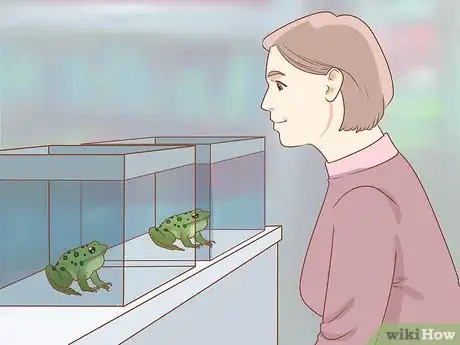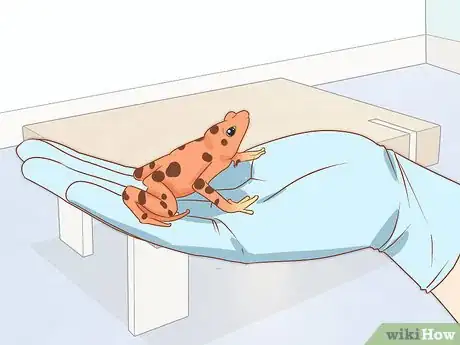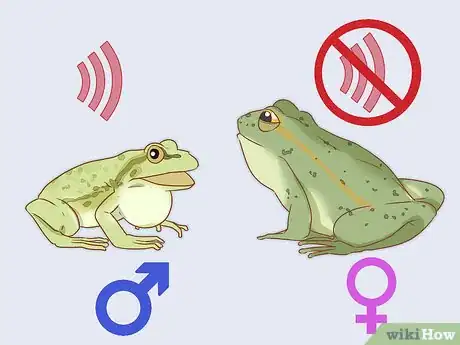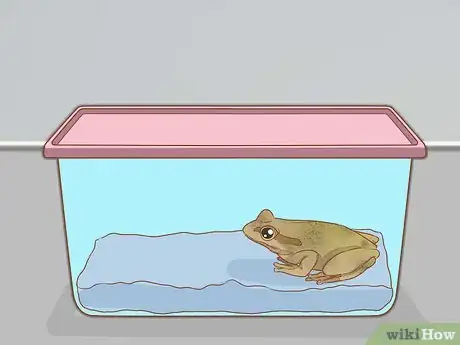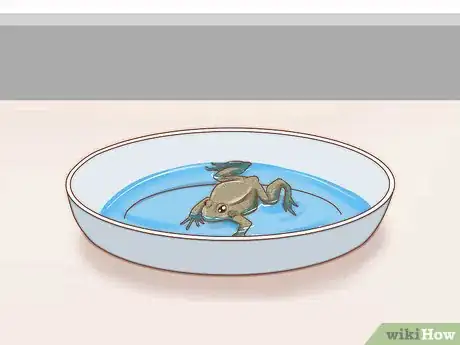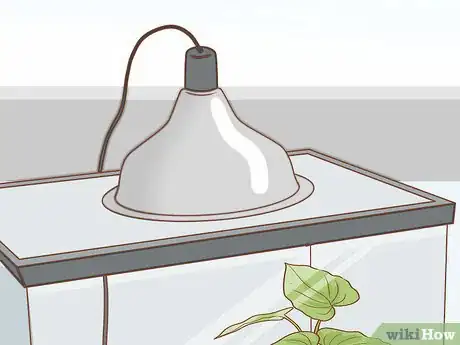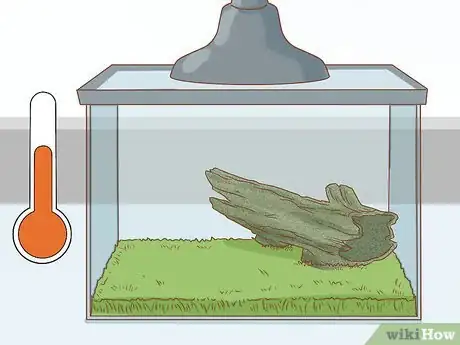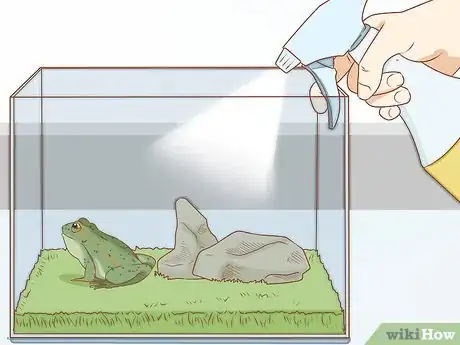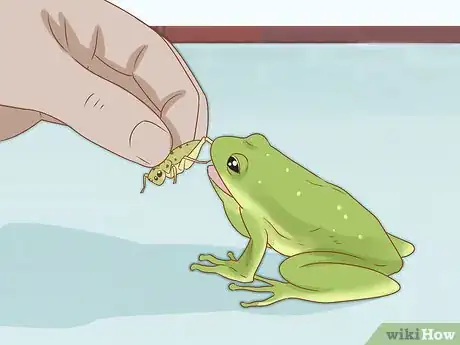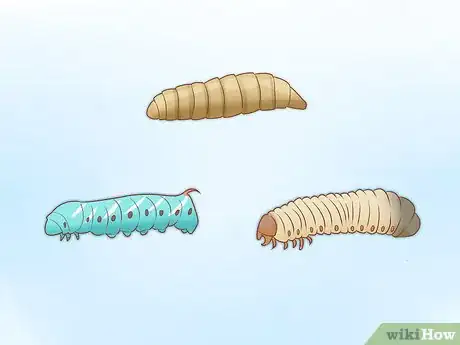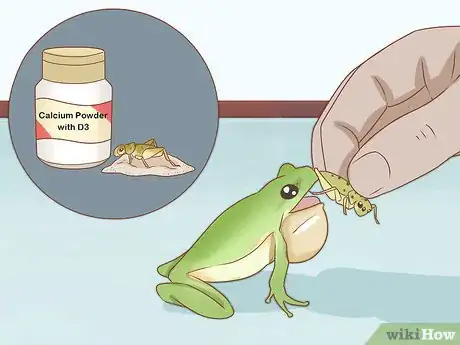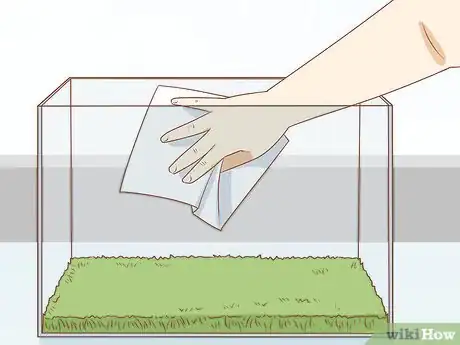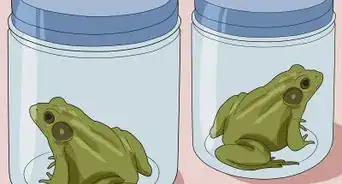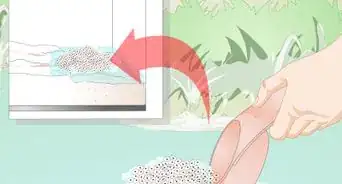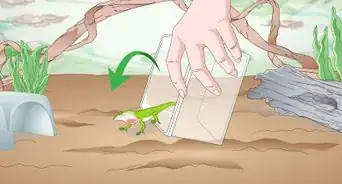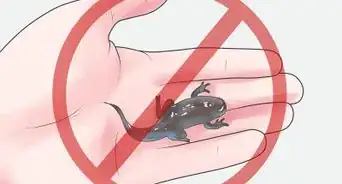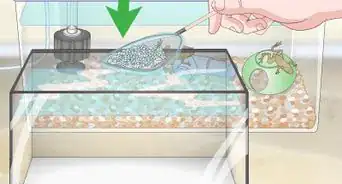This article was co-authored by Pippa Elliott, MRCVS. Dr. Elliott, BVMS, MRCVS is a veterinarian with over 30 years of experience in veterinary surgery and companion animal practice. She graduated from the University of Glasgow in 1987 with a degree in veterinary medicine and surgery. She has worked at the same animal clinic in her hometown for over 20 years.
There are 8 references cited in this article, which can be found at the bottom of the page.
wikiHow marks an article as reader-approved once it receives enough positive feedback. This article has 25 testimonials from our readers, earning it our reader-approved status.
This article has been viewed 630,270 times.
If you're interested in frogs, the American Green Tree Frog (Hyla cinerea) may be a good pet for you. Although you shouldn't handle them, tree frogs are cute and fun to watch. They prefer to live alone, so you will only need one. With proper care and feeding, you can hope to enjoy your little frog for five years. If you are looking for a simple pet that is easy to care for, or a “starter” pet for an older child, green tree frogs are an excellent bet.
Things You Should Know
- Shop around for a captive-bred tree frog that is healthy, with bright green coloring and alert eyes.
- Add lining to a glass aquarium before furnishing it with sticks, rocks, branches, foliage, a water bowl, and a heat source.
- Mist your frog every day and feed it a diet of crickets and other insects.
- Make sure you give the frog's tank a light clean daily and a deep clean once a month.
Steps
Buying Your Frog
-
1Shop around. Before buying frogs, check out the specimens at multiple pet stores. Different stores have different quality standards regarding the frogs they source, and how well they care for them once they are in the shop. A happy, healthy frog will be easier to keep and will have a much longer lifespan.
- Look for a bright green coloring. A healthy American tree frog will be a light lime green to a dark olive or emerald green, with a creamy white to yellow stripe on their sides and creamy white belly. They will change color slightly as a means of camouflage and to indicate mood changes.
- Look for frogs that have bright eyes and seem alert.
- Avoid frogs with brown spots, dull skin, or dry skin. Extreme changes in color, like turning yellow-green or dark brown, can indicate stress or illness.
-
2Always buy captive bred (CB) frogs. Wild caught (WC) frogs are likely to carry disease, which will spread to your other frogs. Wild caught frogs also suffer from stress in captivity, so it is cruel to keep them. Wild caught frogs may also be very old, so their remaining lifespan will be quite short.Advertisement
-
3Keep only one species of frog in each habitat. If you want to buy a new type of frog, you'll need to set up an entirely different vivarium habitat for it. Different species of frogs also have different care needs.[1]
- Certain varieties of frogs are dangerous when housed with other types, which will be very stressful to your frog.
- Frogs are also cannibalistic so a small frog could be lunch for a larger frog.
-
4Always wear gloves. Your tree frog does not need love and affection. These are observational animals and thus do not like to be held. A frog's skin is very delicate and the oils on your skin can be very harmful to them.
-
5Determine your frog's sex. It isn't necessary to know your frog's sex, but the males tend to be a lot noisier than the females. If you will be keeping your frog in your bedroom, try to purchase a female frog.
- Males are usually smaller than females and have yellow or greenish-yellow throats.
- At about 1 year of age, males will begin to call. The call gradually becomes louder and louder, and lasts about 20 seconds.
- Females are usually larger than males, and they have creamy white throats.
- Females don't call all the time, although they will make a short brief response call to a male. They will also sometimes call in distress when they are annoyed by being handled or by another frog sitting on them.
-
6Quarantine new frogs. Before you add a new frog to an enclosure with existing ones, you should keep it in its own habitat for at least three months. If your frog shows no signs of illness, infection, or parasites after three months, you can introduce him to your other frogs.
- A lengthy quarantine time is necessary because symptoms of sickness or parasites do not always appear right away.
Setting Up Your Frog's Habitat
-
1Buy a glass aquarium. Your frog is native to a semi-tropical climate, so it needs a semi-tropical setup. Glass aquariums work best because they are easy to clean and the frogs are clearly visible from outside.[2]
- You will need to buy an aquarium with no less than a 10 gallon capacity. If you want to go larger, your frog will appreciate it.
- Try to find an enclosure that is taller than it is wide, because tree frogs prefer to have vertical mobility.
- Add a screened lid on top for good ventilation. If you have other animals in the house, get one you can lock in order to keep your frogs safe.
-
2Place a lining (substrate) over the bottom of the enclosure. Artificial substrate works best, because there is no risk of a frog ingesting anything while feeding. Line the bottom of the cage carefully, making sure you don't leave any open areas at the edges where your frog can become trapped and injure itself.
- A good substrate is Astroturf, which you can find at hardware stores and sometimes pet stores.
- You can also use reptile carpeting, found at pet stores.
-
3Add artificial cage furniture. This is your frog's home, and it will want things to climb on like logs, rocks, and branches. Arrange your wooden pieces on the diagonal, from corner to corner, and slant them upward from low to high so your frog can climb up them.[3]
- Artificial cage furniture is easy to clean, and you can find a wide variety of specialized items online or at your local pet store.
-
4Add natural cage furniture from outdoors, if you wish. Your best choices are driftwood, cork bark, sticks and branches. If you collect items from outside, you must disinfect them before putting them in your frog's habitat.[4]
- Soak outdoor items in a mild bleach and water solution overnight (one part bleach to three parts water).
- Remove the items from the bleach, and soak them in clean water for an additional night.
- Allow them to air dry thoroughly before adding them to the aquarium. This should kill any bacteria or bugs that may harm your frog.
- Smell each item before placing it in the enclosure, to be sure the items are not releasing any fumes.
-
5Add foliage. You can use live plants or artificial ones. Live plants can be difficult to keep alive indoors, so it's usually best to go with plastic foliage. Artificial plants are also easier to clean, and you can find a wide variety of them online or at your local pet store.[5]
- Another option is to use air plants, living plants that do not require soil or water – they thrive with just an occasional misting. Just be sure to protect them from harsh, direct sunlight or heat lamps, so they won't dry out.[6]
- Sufficient foliage provides “cover” for your frog, helping it to feel safe and secure.
-
6Provide a suitable water bowl. Your frog will need a water bowl that is big enough to climb around in, because it will want to soak and defecate in its water bowl. Choose a bowl that is heavy enough that your frog won't knock it over. Most pet stores carry bowls specifically designed for small amphibians, that are shaped like little ponds to look natural in your aquarium.[7]
- Be sure to clean your frog's water bowl daily – or whenever you notice it is dirty – to prevent bacterial infections.
-
7Add a heat source. If you have a glass terrarium, you can use an under-tank heater placed under one end of the aquarium (never in the center.) Alternatively, you can put a nocturnal heat lamp (no stronger than 15 watts) over the tank, above the highest point in your frog's habitat.[8]
- Never use an under-tank heater with a wooden enclosure, as this may cause a fire.
- Try placing a rock over the heated area of the terrarium floor, which will absorb heat. Your frog may enjoy sitting on the heated rock.
- If you use an overhead heat source, be sure there is a screen lid to the tank between your frog and the heating bulb.
-
8Adjust for temperature and humidity. Green tree frogs are nocturnal, so they won't need any special lighting. However, you will need to adjust for temperature and humidity in order to keep your frog healthy and comfortable.
- The daytime temperature of the habitat at the warmest spot (by the heater) should be about 78 degrees Fahrenheit in the winter and about 80 degrees in the summer.
- The rest the tank (the areas not immediately surrounding the heater) should be about 76 Fahrenheit degrees in winter, 78 degrees in summer.
- At night, you should keep the habitat around 70 degrees in winter, 75 degrees in summer.
- Keep the humidity in the tank around 30% in the winter, and 35% in the summer.
- Hang temperature strips and humidity gauges in the terrarium to maintain proper levels.
-
9Avoid placing the tank in your bedroom. The males "chirp" very loudly at night, and it will wake you up. If noises tend to keep you awake, you may want to keep your frog in a room where you will not be trying to sleep.[9]
- Females are quieter than males, but it is best to prepare for your frog to make noise sometimes.
- Frogs may also chirp at vacuum cleaners, running water, lawnmowers, and certain TV commercials.
- Males may make loud calls during a falling barometer, so your frog might warn you when it's about to rain.
Caring for Your Frog
-
1Water and mist your frog daily. Be sure your frog's water dish is clean and full of fresh water. Spray your frog and its enclosure daily with water to keep everything moist and help with the overall humidity in the habitat.[10]
- Frogs have permeable skin – they drink water as well as breathe through their skin.
- Always use Reverse Osmosis (RO) or distilled water for your frogs.
- Standard tap water, even if dechlorinated, will still have heavy metals and other contaminants which can harm your critters.
-
2Feed your frog crickets and other insects. Your frog will enjoy many types of insects, including crickets, moths, pillbugs, and small dubias or lobster roaches. Feeder insects can be purchased online or at pet stores.[11]
- Try to feed your frog insects that are no larger than the width between its eyes.
- Don't feed your frog bugs you catch outdoors, because they may be infested with parasites or full of poisonous pesticides.
- Some insects are toxic for frogs. Never feed your pet frog ladybugs, stinkbugs, millipedes or praying mantis.
-
3Feed your frog a wide variety of prey foods. Proper nutrition comes from a well-rounded diet – this will lengthen your frog's life and improve its resistance to illness. In addition to bugs and other insects, your frog will enjoy other small prey animals that are small enough to fit easily into its mouth. These should be purchased at a pet store or online – it can be harmful to your frog to feed it wild bugs and worms from your back yard.[12]
- Bear in mind that frogs eat live prey. If you are squeamish about putting live insects into your frog's habitat, you may want to consider a different type of pet.
- Try feeding your frog caterpillar larvae, such as wax worms, horn worms, and silkworms.
- You can also feed your frog the occasional small earthworm or red wiggler.
-
4Supplement your frog's diet with vitamins and minerals. Lightly coat their prey items with calcium powder with D3, multivitamin powder, and minerals. All these are readily available, last a long time, and are not very expensive. Dust an adult frog's food every two to four feedings, more often for juvenile frogs.[13]
-
5Clean your frog's enclosure regularly. Once a month, be sure to totally clean out the aquarium and thoroughly wash the items inside with hot water and let cool before returning the items to the enclosure. Also, a regular (daily) inspection and cleanup is recommended to help remove feces, damaged plant matter, and dead prey items.[14]
- If you need to handle your frog in order to clean his habitat, always wet your hands with de-chlorinated water (water from a water bottle.) The natural oils in your skin can be toxic to frogs.
- Avoid using chemicals to clean. When cleaning the frog's enclosure, never use chemicals. Even trace amounts of chemicals can burn your frog's skin, or even kill him.
Warnings
- Avoid handling frogs as much as possible. This causes much stress to the frog and their skin is very sensitive. The oils, lotions, soaps etc. left on your skin are poisonous to the frog. They are also very jumpy, so be careful!⧼thumbs_response⧽
- Supplies aren't cheap. Be prepared to spend a lot of money.⧼thumbs_response⧽
- Never use soap or chemicals when cleaning the tank. Frogs easily absorb chemicals through their skin.⧼thumbs_response⧽
- If you are squeamish, this may not be the pet for you, since you will need to feed your frog live insects.⧼thumbs_response⧽
Things You'll Need
- Healthy Frog(s)
- Glass tank
- Substrate
- Artificial/Real plants
- Invertebrates (food)
- Spray Bottle
- RO or Distilled Water
- Lid for tank
- Powdered supplements for their food
References
- ↑ http://allaboutfrogs.org/info/doctor/common.html#mix
- ↑ http://www.anapsid.org/greentreefrog.html
- ↑ http://www.anapsid.org/greentreefrog.html
- ↑ http://www.anapsid.org/greentreefrog.html
- ↑ http://www.anapsid.org/greentreefrog.html
- ↑ http://www.bhg.com/gardening/houseplants/care/grow-air-plants/
- ↑ http://www.reptilesncritters.com/care-guide-green-tree.php
- ↑ http://www.anapsid.org/greentreefrog.html
- ↑ http://www.reptilesmagazine.com/Care-Sheets/Green-Treefrog/
About This Article
To care for a green tree frog, give your frog live insects like crickets, moths, silkworms, or waxworms. Then, occasionally coat its prey with calcium powder so it's getting sufficient vitamins and minerals. When you're setting up its habitat, cover the bottom of a glass aquarium with an astroturf substrate, and add driftwood, bark, and artificial rocks for your frog to climb on. Additionally, to keep your frog healthy, place a water bowl in the cage that's large enough for your frog to soak in but small enough that it doesn't get knocked over frequently. Moreover, be sure to mist your frog with water daily so it stays moist. To find out why you should buy captive bred frogs and why you should only keep one species, keep reading!
